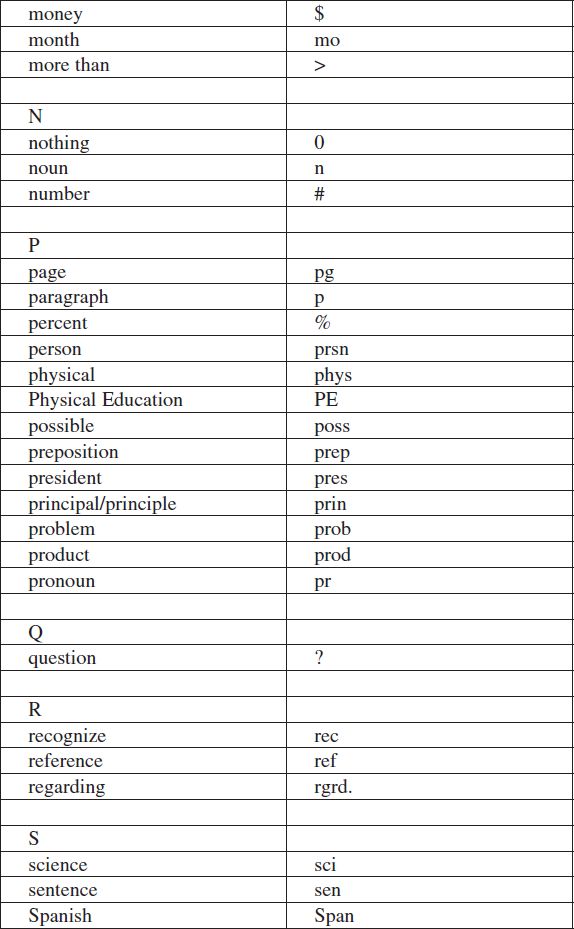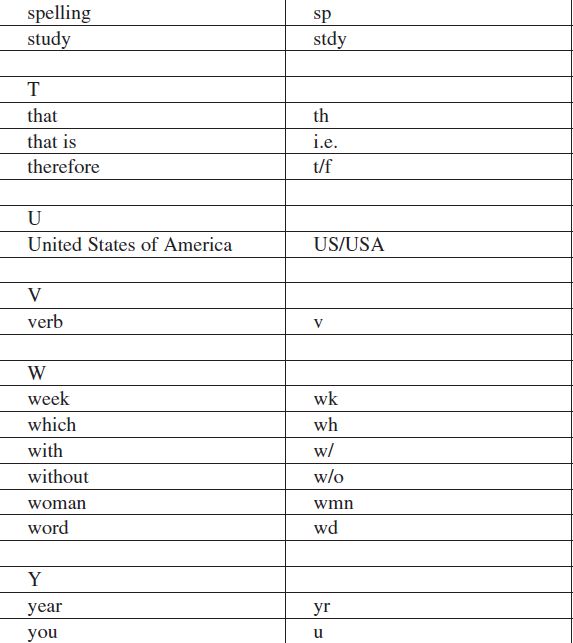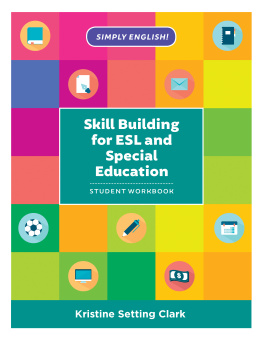
Simply Notetaking
and Speedwriting
Simply Notetaking
and Speedwriting
Learn How to Take
Notes Simply and Effectively
Kristine Setting Clark
ROWMAN & LITTLEFIELD
Lanham Boulder New York London
Published by Rowman & Littlefield
An imprint of The Rowman & Littlefield Publishing Group, Inc.
4501 Forbes Boulevard, Suite 200, Lanham, Maryland 20706
www.rowman.com
86-90 Paul Street, London EC2A 4NE, United Kingdom
Copyright 2022 by Kristine Setting Clark
All rights reserved. No part of this book may be reproduced in any form or by any electronic or mechanical means, including information storage and retrieval systems, without written permission from the publisher, except by a reviewer who may quote passages in a review.
British Library Cataloguing in Publication Information Available
Library of Congress Cataloging-in-Publication Data
Names: Clark, Kristine Setting, 1950 author.
Title: Simply notetaking and speedwriting: learn how to take notes simply and effectively / Kristine Setting Clark.
Description: Lanham, Maryland: Rowman & Littlefield, 2022. | Includes bibliographical references. | Summary: Simply Notetaking and Speedwriting will teach the student how to record notes in various formats and how to utilize notetaking when studying or reviewing for an examProvided by publisher.
Identifiers: LCCN 2021037548 (print) | LCCN 2021037549 (ebook) | ISBN9781475850871 (cloth) | ISBN 9781475850888 (paperback) | ISBN 9781475850895 (epub)
Subjects: LCSH: Note-takingHandbooks, manuals, etc.
Classification: LCC LB2395.25 .C53 2022 (print) | LCC LB2395.25 (ebook) | DDC 371.30281dc23
LC record available at https://lccn.loc.gov/2021037548
LC ebook record available at https://lccn.loc.gov/2021037549
 The paper used in this publication meets the minimum requirements of American National Standard for Information SciencesPermanence of Paper for Printed Library Materials, ANSI/NISO Z39.48-1992.
The paper used in this publication meets the minimum requirements of American National Standard for Information SciencesPermanence of Paper for Printed Library Materials, ANSI/NISO Z39.48-1992.
Contents
Simply Notetaking and Speedwriting is a simple and effective notetaking program that is essential to student academic success. Notetaking is a major component in learning and understanding how to recognize and identify main ideas, key facts, and details.
Simply Notetaking and Speedwriting will also teach the student how to record notes in various formats and how to utilize notetaking when studying or reviewing for an exam. Worksheets and practices are included in many of the chapters.
What makes Simply Notetaking and Speedwritingdifferent from other notetaking curriculums is that it teaches a form of shorthand to notetaking. For example, in chapters 2 and 3 the student will be taught how to utilize speedwriting when taking notes. They will also be guided through developing their own, personal speedwriting system. Included at the back of the book is an extensive, alphabetized catalog of Commonly Used Words and Their Speedwriting Abbreviations.
Taking effective notes, whether by hand or on a computer/tablet, helps the student to retain information on what has been said or written down long after the lecture or classroom lesson is over.
Whether you are taking notes from a book, for research, from a lecture, from a recording or from media/online resources, Simply Notetaking and Speedwriting will give you the tools to retain information and master the skill of notetaking.
Chapter 1
The Importance of Notetaking
The ability to take clear and comprehensive notes is vital to students academic success. Good notetaking allows students to understand and learn course material for assignments and exams.
The following are four reasons for taking good notes.
- Notetaking helps you to pay attention. Your concentration will become better because you now have something specific to focus on. It also helps you to remember the ideas that you are writing down.
- Whats important and whats not important will become easier for you to recognize.
- You will always have a permanent record of notes from the various lectures and chapters that you have read.
- By reviewing your notes regularly, you will be able to remember what you have read or heard. Notetaking also helps you to organize your ideas.
Now lets pretend that you are home alone. The phone rings, and its for your brother, Brian. Its his baseball coach and he has a message for him that is very important. You ask the coach to hold on for a moment while you get paper and a pen. You ask the coach to speak slowly so that you can write down EVERY word.
Brian:
Practice has been changed. It will be at 3:30 at Lincoln High School instead of 4:00 at Washington High School.
If you had been skilled in notetaking, you may have written it like this:
Bri Prac chngd fr Wash. @ 4 to Linc. @ 3:30
Instead of writing down each and every word of the phone message, all you would have needed to do was write down the main facts. The main facts are what allow your memory to remember what was said. This is what notetaking is all about.
Chapter 2
SpeedwritingA Shortcut to NotetakingCommon Abbreviations
Many students find it to their advantage to abbreviate certain words. It helps them to write faster and concentrate more on what they are reading or listening to. More often than not, some students create/invent their own notetaking abbreviations sometimes, without even knowing it.
When creating your own system of abbreviations watch out for the following:
- Be careful not to use the same abbreviation for more than one word if possible, but you should be able to identify the word according to the context in which it is used.
- You want to be able to easily read back what you have written down. To insure this, do not crowd your words as if you were writing a composition. Leave enough space between each word so that your notes will be clear and easy to read.
- Do not use periods when abbreviating. Periods are only used in place of the participle ing. An example of this is the word going. The shorthand version of ing is a period. In other words, you would write going like this: go.
- Use technical symbols such as: & (and), + (add, plus), (less, minus), $ (dollars, money), % (percent), @ (at), ? (question), ! (to exclaim or show importance).
- Always use standard, English abbreviations. Here are a few examples:




- Eliminate vowels whenever possible. Heres an example: developed (dvlpd), individual (indv). For words ending in ment, draw a line (____). For example: development (dvlp__). And as stated previously, use a period(.) for words ending in ing. For exampledeveloping (dvlp.).
To become successful in your notetaking, you will need to memorize (remember) the symbols (abbreviations) that you have chosen to use. The whole idea of notetaking is to omit as many letters as possible and still be able to recognize the word. If the original word is long, it will be easier to recognize its abbreviation. If the original word is short, it will be easier to read back if you
Next page











 The paper used in this publication meets the minimum requirements of American National Standard for Information SciencesPermanence of Paper for Printed Library Materials, ANSI/NISO Z39.48-1992.
The paper used in this publication meets the minimum requirements of American National Standard for Information SciencesPermanence of Paper for Printed Library Materials, ANSI/NISO Z39.48-1992.


